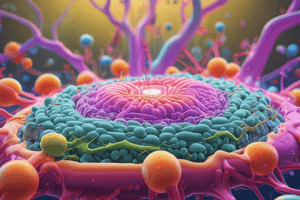Podcast
Questions and Answers
Which molecules do not normally cross the nuclear membrane?
Which molecules do not normally cross the nuclear membrane?
- mRNA
- Proteins
- Nucleotide triphosphates
- DNA (correct)
Which of the following statements about the nuclear envelope is false?
Which of the following statements about the nuclear envelope is false?
- Nuclear pores are made up of proteins that are collectively called the nuclear pore complex.
- The nuclear envelope is composed of two lipid bilayers.
- Molecules pass into and out of the nucleus through nuclear pores.
- The nuclear envelope is continuous with the Golgi apparatus. (correct)
Large proteins containing a nuclear localization signal (NLS) bind to the nuclear pore and enter the nucleus without any expenditure of energy.
Large proteins containing a nuclear localization signal (NLS) bind to the nuclear pore and enter the nucleus without any expenditure of energy.
False (B)
A small protein (molecular weight = 25,000 daltons) is injected into a cell and observed in the nucleus a short time later. What type of transport has taken place?
A small protein (molecular weight = 25,000 daltons) is injected into a cell and observed in the nucleus a short time later. What type of transport has taken place?
In experiments to test whether a protein can enter the nucleus, why would proteins be labeled with fluorescent molecules?
In experiments to test whether a protein can enter the nucleus, why would proteins be labeled with fluorescent molecules?
Which of the following conclusions can be drawn from the results of injecting fusion proteins into a cell?
Which of the following conclusions can be drawn from the results of injecting fusion proteins into a cell?
What is the most likely pathway taken by a newly synthesized protein that will be secreted by a cell?
What is the most likely pathway taken by a newly synthesized protein that will be secreted by a cell?
How are these signals read?
How are these signals read?
Which statement most accurately describes what happens to proteins that lack an ER signal sequence?
Which statement most accurately describes what happens to proteins that lack an ER signal sequence?
In receptor-mediated endocytosis, receptor molecules initially project to the outside of the cell. Where do they end up after endocytosis?
In receptor-mediated endocytosis, receptor molecules initially project to the outside of the cell. Where do they end up after endocytosis?
Study Notes
Nuclear Transport and Proteins
- DNA does not normally cross the nuclear membrane, whereas RNA and proteins can.
- A false statement about the nuclear envelope is that it is continuous with the Golgi apparatus; it consists of two lipid bilayers and has nuclear pores for molecule transport.
- Large proteins with a nuclear localization signal (NLS) require energy to bind to the nuclear pore for entry into the nucleus; thus, the statement that they enter without energy expenditure is false.
- A small protein of 25,000 daltons can enter the nucleus via passive transport, which does not require energy.
Labeling and Fusion Proteins
- Fluorescent labeling of proteins in experiments allows for easier visualization rather than increasing size or providing energy.
- Nucleoplasmin, when divided and fused with a cytoplasmic protein, demonstrated that only one of the fusion proteins contains a nuclear localization signal.
Secretion Pathway for Newly Synthesized Proteins
- Newly synthesized proteins destined for secretion typically follow the pathway: ER → Golgi → vesicles that fuse with the plasma membrane.
- Signals that guide the proteins through the secretion pathway achieve their function by binding to receptor proteins.
Proteins without ER Signal Sequences
- Proteins lacking an ER signal sequence are released into the cytosol rather than entering the ER or Golgi apparatus.
Receptor-Mediated Endocytosis
- In receptor-mediated endocytosis, receptor molecules that initially face outward end up on the inside surface of the vesicle after the process concludes.
Studying That Suits You
Use AI to generate personalized quizzes and flashcards to suit your learning preferences.
Description
Test your knowledge on the topics from Biology chapters 7.4 and 7.5 with these flashcards. This quiz will cover key concepts about the nuclear membrane and envelope, including what molecules can cross and the structure of nuclear pores. Perfect for review and mastery of important biological concepts.




